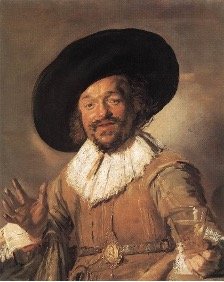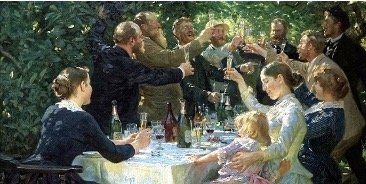I’ll have the Hemingway!: Deep diving the tangled relationships between alcohol, art, and the artist
Chloe Marschner
Alcohol has long infused the realm of the arts. From written mediums to visual mediums, a huge number of our most famous and noteworthy artists and writers have had a tangled relationship with alcohol. Whilst we know that there is a long-established link[1] between psychoactive substances and art, we will look a little closer at the relationship between alcohol, the art, and the artist behind it all.
The depiction of alcohol in art[2] has certainly shifted in tone over time. In more classic works of art, we see examples such as the revelling and cheery wine-drinkers in Diego Velázquez’s ‘The Triumph of Bacchus’, and the gleaming and slightly sozzled drinker in Frans Hals’ famous portrait.
‘The Triumph of Bacchus’ by Diego Velázquez
‘The Merry Drinker’ by Frans Hals
The jubilations continue in Peder Kroyer’s painting of the party toast, with wine glasses bathed in luminescent and almost deific sunlight. In these artworks, alcohol provides a gleaming light, a cause of merriment and communal joy. Yet Vincent van Gogh’s ‘The Drinkers’, whilst depicting three men drinking together, takes an altogether different turn. The drinkers are leant in and the unhealthy need for their drink is apparent. Even the painting strokes seem erratic and sickly.
‘Hip, Hip, Hurrah’ by Peder Kroyer
Van Gogh’s ‘Still Life with Absinthe’ carries over this darker tone of alcohol consumption, with single glass envisaging the solitary, miserable drinker. A known abuser of absinthe, this painting holds another layer of resonance for Van Gogh. One of the most potent examples of the ravages of alcohol is that of William Hogarth’s ‘Gin Lane’. This almost biblical scene depicts the disastrous effects of gin, then known as “mother’s ruin”, during a period of history when gin was cheaper than beer. With babies being dropped and violent mayhem in the background, it’s clear that gin was not exactly thought of fondly during this time.
‘The Drinkers’ by Vincent Van Gogh
‘Gin Lane’ by William Hogarth
Alcohol not only finds its home as the subject of artwork, but also as a fuel for the artists themselves. Artists such as Maurice Utrillo (the post-impressionist painter who famously would trade his paintings for drinks) and abstract painter Jackson Pollock were both known alcoholics. Another artistic group famous for their overconsumption of alcohol is that of writers. Bucketfuls of writers over the centuries have been addicted to alcohol; many of them writing about it in compelling and memorable ways. Some of the most famous[3] include Hemingway, who drank “to make other people more interesting”, or F. Scott Fitzgerald, who came out with the famous line, “first you take a drink, then the drink takes a drink, then the drink takes you.” And poised somewhere between horror and comedy is the famous daily routine of Hunter S. Thompson, which features no less than fifteen drinks from the hours of 3pm to 3.20am, along with a noxious cocktail of other psychoactive substances. From Steinbeck to Joyce to Bukowski, the fate of many writers is epitomised by Brendan Behan’s comment that he is a “drinker with a writing problem." One only has to look at the proportion of the winners of the Nobel Prize for Literature who were alcoholics to make some kind of deductions – in 1979, four out of the previous six winners were severely addicted to alcohol[4].
We see these figures and we might wonder why the link between literary greats and alcohol is so well-established. Many writers have offered their own eloquent reasons for doing so. Hemingway explained that, “modern life is often a mechanical oppression and liquor is the only mechanical relief.” This kind of self-medicative explanation is common amongst the classic visions of the solitary and tortured writer. And if one wishes to pathologize, one can. One seminal psychological study[5] conducted in 1987 compared two groups of people, who were closely matched to each other in terms of age, gender, education and intelligence. The only difference between the groups was that one group were writers and the other were non-writers. And indeed, they found that the writers had much higher incidences of both alcoholism and bipolar disorder than non-writers. Culturally, there is also a strong association of writers with depression, for they are the ones who deal with the mechanics of existential despair and the follies of humankind, and that kind of thing. The very job of writing requires a lot of alone time, and with so much solitary activity, a little cognitive easing might understandably be needed. Psychiatrist Dr. Donald W. Goodwin notes that the experiences of being drunk and writing are rather similar, as they both mimic almost trance-like states. So perhaps it is also the case that people prone to either writing or drinking will also be prone to the other, as they are not so dissimilar activities. Perhaps more sceptically, Leslie Fielder notes that in the western literary tradition, writers needed a characteristic flaw[6], to add a little texture to their author persona. Alcoholism, and the almost romanticised self-destruction this came with, was rather well suited to many writers, and the romanticism thereof perhaps fuelled what was already a burgeoning alcoholism.
More optimistically, we could also see the prevalence of alcoholism amongst writers as being a result of the enhanced creativity that a strong drink can bring about. Having decreased one’s inhibitions, an optimal level of drunkenness can be the perfect cocktail to create unusual and original connections, and make a truly legendary piece of work. Something even worthy of a Nobel Prize for Literature perhaps… There’s also an awareness that alcohol can act as a sort of ‘mystical transport’[7], having been used in religious practices for many years. Writer Patricia Highsmith recognised[8] this potential for creativity and almost transcendence, and stated that as an artist, drinking made her “see the truth, the simplicity and the primitive emotions once more." Unfortunately, we saw her not a decade later tucking into bed at 4pm with a fresh bottle of gin. The grim reality of alcoholism somewhat counters the glamour and the mystique of the alcoholic writer phenomenon. Many of these famed alcoholic literary greats died at a young age, often of suicide or other alcohol-related health conditions.
In this vein, many people have pointed out the ‘bohemian chic’[9] vibe associated with particularly dead alcoholic male writers. One only has to consult the menu of some hip bar to see ‘Hemingway’s Mojito’, or ‘Faulkner’s Mint Julep’. These cocktails seem to trivialise what actually finished off a lot of these writers, and in doing so, iconise them to almost a legendary status. Another interesting way in which alcohol and literature are regarded is the difference between British and American literary content. Writing about literary works published in Britain and Ireland tends to focus more frequently on how the convivial or melodramatic aspects of alcohol are created. So instead of rack and ruin, drunken characters frequently add some flavour or drama to texts. We could see this as the fictionalisation of alcohol, with the author rarely being brought up in the same conversations. Yet when you look at the alcohol-related literature in America, you can see it is completely saturated with writing about the alcoholism of the writer. This is what is known as alcoholism literature, in all its glory. It is common to see the exact quantities and combinations of the drinks drunk by these drunks almost valorised, and held up to the light in some kind of warped fascination. Immortalised in bar menus and witty quotes, America is scattered with the legacies of beatified writers in the throes of alcoholism. Certainly an interesting difference across the Atlantic, between the great literature and the literary greats.
Alcohol finds its place both in the foreground and the background of the arts, across paintings, literature, and other forms of art. Seemingly more often than not, famous and notable artists and writers have been caught in the grasps of alcoholism. Some claimed the enhanced ability of their creative process or made alcohol the focus of their work, whilst some relied on alcohol just to keep them going. These relationships are ever-changing and ever-shifting, but it may always be the case that alcohol soaks the art that we consume.
References
[1] Ciobica, I., et al. (2015) General aspects regarding the phenomenon of alcoholism in literature. International Letters of Social and Humanistic Sciences. 57. 35-41. Available at: https://www.researchgate.net/publication/283161682_General_Aspects_Regarding_the_Phenomenon_of_Alcoholism_in_Literature
[2] Harris, J. (2013) ‘Cultural aspects: representations of alcohol use in visual art.’ In Boyle, P. (Ed.), Alcohol: Science, Policy and Public Health. 24-29. Available at: https://oxford.universitypressscholarship.com/view/10.1093/acprof:oso/9780199655786.001.0001/acprof-9780199655786-chapter-03
[3] O, Neill, A. (2015) Booze as muse: Writers and alcohol, from Ernest Hemingway to Patricia Highsmith. Irish Times. Available at: https://www.irishtimes.com/culture/books/booze-as-muse-writers-and-alcohol-from-ernest-hemingway-to-patricia-highsmith-1.2369720
[4] Hyde, L. (1979) Alcohol and Poetry. Dallas Institute Publications. Available at: https://lewishyde.com/wp-content/uploads/2021/11/18AlcoholandPoetry.pdf
[5] Andreasen, N. C. (1987). Creativity and mental illness: Prevalence rates in writers and their first-degree relatives. The American Journal of Psychiatry, 144,10. 1288–1292. Available at: https://psycnet.apa.org/record/1988-07533-001
[6] Ciobica, I., et al. (2015) General aspects regarding the phenomenon of alcoholism in literature. International Letters of Social and Humanistic Sciences. 57. 35-41. Available at: https://www.researchgate.net/publication/283161682_General_Aspects_Regarding_the_Phenomenon_of_Alcoholism_in_Literature
[7] Ibid.
[8] O, Neill, A. (2015) Booze as muse: writers and alcohol, from Ernest Hemingway to Patricia Highsmith. Irish Times. Available at: https://www.irishtimes.com/culture/books/booze-as-muse-writers-and-alcohol-from-ernest-hemingway-to-patricia-highsmith-1.2369720
[9] Klepuszewski, W. (2018) Drink and Alcohol Literature: Two Critical Perspectives. HJEAS. 24,2. Available at: https://ojs.lib.unideb.hu/hjeas/article/view/7236/6643





